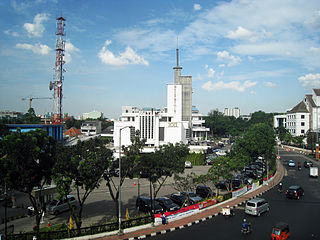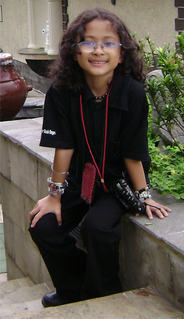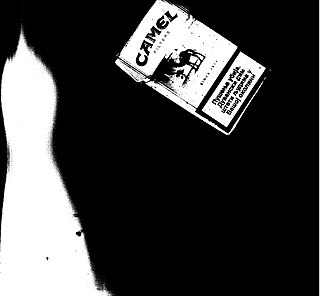
Raden Saleh Sjarif Boestaman was a pioneering Indonesian Romantic painter of Arab-Javanese ethnicity. He was considered to be the first "modern" artist from Indonesia, and his paintings corresponded with nineteenth-century romanticism which was popular in Europe at the time. He also expressed his cultural roots and inventiveness in his work.

Ragunan Zoo is a zoo located in Pasar Minggu, South Jakarta, Indonesia. The zoo has an area of 140-hectare (350-acre). The zoo has an aviary and included a primate centre, and employs over 450 people. Many of the animals are endangered and threatened from all parts of Indonesia and the rest of the world. There are a total of 3,122 animal specimens including birds. Laid out in a lush tropical setting, rare animals such as crocodile, gorilla, orangutan, tapir, anoa, sumatran tiger, babirusa and peacocks are given ample room. The zoo is located in South Jakarta and is easily accessible through the Jakarta Outer Ring Road and TransJakarta Corridor 6 bus.
Taman Impian Jaya Ancol otherwise known as Ancol Dreamland is an integral part of Ancol Bay City, a resort destination located along Jakarta's waterfront, in Ancol (Kelurahan), Pademangan, Indonesia. It is owned by PT. Pembangunan Jaya Ancol Tbk, a subsidiary of Pembangunan Jaya Group. Ancol Dreamland opened in 1966 and is currently the largest integrated tourism area in South East Asia, boasting an international championship golf course, a theme park, hotels and other recreational facilities.
I Gusti Ngurah Putu Wijaya, better known simply as Putu Wijaya, was born in Tabanan, Bali. He is an Indonesian author, considered by many to be one of Indonesia's most prominent literary figures. His output is impressive; his published works include more than thirty novels, forty dramas, a hundred short stories, and thousands of essays, articles, screenplays and television dramas, and he has been the recipient of a number of literary prizes.

Senen is a commercial center in Jakarta, Indonesia. The area was developed in the 18th-century as Pasar Senen at the time when governor Daendels established the bovenstad as the new center of government of Batavia. The area is one of the oldest commercial center in Jakarta. This historic commercial center of Senen is located in what is now the Administrative Village of Senen, in the northern part of the Senen Subdistrict. This article covers both Senen as the historic commercial center and as a Subdistrict of Central Jakarta.

Ismail Marzuki was an Indonesian composer, songwriter and musician who wrote around 202 to 240 songs between 1931 and 1958, including numerous popular patriotic songs. Among his best-known works are "Halo, Halo Bandung", "Gugur Bunga", and "Rayuan Pulau Kelapa". In 1968, he was honoured with the creation of the well-known Taman Ismail Marzuki which is a cultural centre in Menteng in central Jakarta. In 2004 he was declared one of the National Heroes of Indonesia.

Willibrordus Surendra Broto Rendra, widely known as Rendra or W. S. Rendra, was an Indonesian dramatist, poet, activist, performer, actor and director.

Metropole is a historic multipurpose building complex in Jakarta, Indonesia. At present Metropole is the oldest surviving movie theater in Jakarta. One of its main tenants is the 21 Cineplex group, which operates the Metropole XXI movie theater in the complex's main building. As a historic cinema, it has screened films during the first Indonesian Film Festival (1955) and the 16th Asia Pacific Film Festival (1970). Metropole was listed as an architectural heritage site by the governor in 1993.

Achdiat Karta Mihardja was an Indonesian author, novelist and playwright. He is best known for his novel, Atheis, which was published in 1949. Atheis is considered one of Indonesia's most important literary works following World War II.

Hans Bague Jassin, better known as HB Jassin, was an Indonesian literary critic, documentarian, and professor. Born in Gorontalo to a bibliophilic petroleum company employee, Jassin began reading while still in elementary school, later writing published reviews before finishing high school. After a while working in the Gorontalo regent's office, he moved to Jakarta where he worked at the state publisher Balai Pustaka. After leaving the publisher, he attended the University of Indonesia and later Yale. Returning to Indonesia to be a teacher, he also headed Sastra magazine. Horison, a literary magazine, was started in July 1966 by Jassin and Mochtar Lubis as a successor to Sastra, and was edited by Taufiq Ismail, Ds. Muljanto, Zaini, Su Hok Djin, and Goenawan Mohamad. In 1971, Jassin was given a one-year prison sentence and a two-year probation period because as the editor of Sastra, he refused to reveal the identity of an anonymous writer who wrote a story which was considered by the court to be blasphemous.

Sigrid Minerva Boni Avibus widely known as Boni Avibus is an Indonesian dramatist, poet, activist, theater performer, actress and orator.

Djadoeg Djajakusuma was an Indonesian film director and promoter of traditional art forms. Born to a nobleman and his wife in Temanggung, Central Java, Djajakusuma became interested in the arts at a young age, choosing to pursue a career in theatre. During the Japanese occupation from 1943 to 1945 he was a translator and actor, and in the four-year national revolution which followed he worked for the military's educational division, several news agencies, and in drama.

Jakarta Planetarium and Observatory is a public planetarium and an observatory, part of the Taman Ismail Marzuki art and science complex in Jakarta, Indonesia. The planetarium is the oldest of the three planetaria in Indonesia. The second planetarium is located in Surabaya, East Java. The third planetarium is located in Kutai, East Kalimantan.
Niniek L. Karim is an Indonesian actress who has won two Citra Awards for Best Supporting Actress.
The Cultural Manifesto was a declaration by a group of Indonesian writers and intellectuals in late 1963. The Cultural Manifesto was initiated by HB Jassin, Trisno Sumardjo, Wiratmo Soekito, Zaini, Bokor Hutasuhut, Gunawan Mohamad, A. Bastari Asnin, Bur Rasuanto, Soe Hok Djin, DS Moeljanto, Ras Siregar, Hartojo Andangdjaja, Sjahwil, Djufri Tanissan, Binsar Sitompul, Gerson Poyk, Taufiq Ismail, M. Saribi, Poernawan Tjondronegoro, Ekana Siswojo, Nashar and Boen S. Oemarjati. The group that constituted the Cultural Manifesto was in ideological contrast to Lekra. Members of the Lekra movement nicknamed the Cultural Manifesto "Manikebu," a humorous abbreviation that in English means "Buffalo Sperm."

Basoeki Resobowo was an Indonesian painter. Born to a transmigrant father in Sumatra, from a young age he showed interest in the visual arts but was taught to be a teacher. After a short time at a Taman Siswa school in Batavia, he studied design and worked as a surveyor while producing sketches and book covers. He only acted in a single film, Kedok Ketawa, but remained close to the acting community, first as a set designer during the Japanese occupation of the Dutch East Indies then for Perfini in the early 1950s.

Ngesti Pandawa is a professional wayang wong or wayang orang art company located in Semarang. The Ngesti Pandawa wayang orang is housed in the Ki Narto Sabdho Hall in Taman Budaya Raden Saleh or the Taman Raden Saleh Cultural Complex at Jalan Sriwijaya 29, Semarang City, Central Java Province, Indonesia. Ngesti Pandawa is one of three surviving wayang orang troupes in Indonesia, besides Wayang Orang Sriwedari in Taman Sriwedari Solo and Wayang Orang Bharata in Jakarta. It is hoped that wayang orang will again be able to entertain generations of audiences while sending a timeless moral message.

The Indonesian New Art Movement, also known as Gerakan Seni Rupa Baru(GSRB) was an art movement of young artists from Bandung and Yogyakarta against the institutional concept of Indonesian fine art being limited to paintings and sculptures. The movement emerged in 1974, first organised in a protest against the judging of the Second Jakarta Painting Bienalle which awarded prizes to decorative style of paintings and sculptures. The protesters published the Black December Statement criticising the lack of social and political consciousness in Indonesian decorative art practices.

Yoes Rizal is an Indonesian painter. He graduated in 1985 from the Department of Art & Design at the Institut Teknologi Bandung (ITB), under Indonesian Muchtar Apin, Kaboel Soeadi, Sanento Yuliman, Ahmad Sadali, Joan Sommers, master of Sumi-e.
Indonesian painting has a very long tradition and history in Indonesian art, though because of the climatic conditions very few early examples survive. The earliest Indonesian paintings were the rock paintings of prehistoric times, such as the petroglyphs found in places like in the caves in the district of Maros in Sulawesi, Indonesia. The Stone Age rock paintings found in the Maros cave are approximately 40.000 years old.















